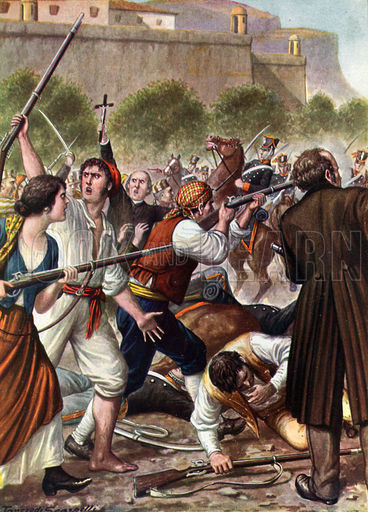|
Decembrist Revolt
The Decembrist Revolt ( ru , Восстание декабристов, translit = Vosstaniye dekabristov , translation = Uprising of the Decembrists) took place in Russia on , during the interregnum following the sudden death of Emperor Alexander I. Alexander's heir apparent, Konstantin, had privately declined the succession, unknown to the court, and his younger brother Nicholas decided to take power as Emperor Nicholas I, pending formal confirmation. While some of the army had sworn loyalty to Nicholas, a force of about 3,000 troops tried to mount a military coup in favour of Konstantin. The rebels, although weakened by dissension between their leaders, confronted the loyalists outside the Senate building in the presence of a large crowd. In the confusion, the Emperor's envoy, Mikhail Miloradovich, was assassinated. Eventually, the loyalists opened fire with heavy artillery, which scattered the rebels. Many were sentenced to hanging, prison, or exile to Siberia. The cons ... [...More Info...] [...Related Items...] OR: [Wikipedia] [Google] [Baidu] |
Revolutions During The 1820s
Revolutions during the 1820s included revolutions in Russia (Decembrist revolt), Spain, Portugal, and Italy for constitutional monarchies, and for Greek War of Independence, independence from Ottoman rule in Greece. Unlike Revolutions of 1830, the revolutionary wave in the 1830s, these tended to take place in the peripheries of Europe. Timeline * 1820: in United Kingdom of Great Britain and Ireland (Cato Street Conspiracy, Radical War) * 1820: in Spain * 1820: the Liberal Revolution of 1820, Liberal Revolution in Kingdom of Portugal, Portugal * 1820: in Italy * 18211829: Greek War of Independence * 1825: the Decembrist revolt in Russia * 1828: the Decembrist revolution (Argentina), Decembrist revolution in Argentina Europe Italy The Ferdinand I of the Two Sicilies#1820 revolution, 1820 revolution began in Kingdom of Sicily, Sicily and in Kingdom of the Two Sicilies, Naples, against King Ferdinand I of the Two Sicilies, who was forced to make concessions and promise a constitut ... [...More Info...] [...Related Items...] OR: [Wikipedia] [Google] [Baidu] |
Napoleon
Napoleon Bonaparte ; it, Napoleone Bonaparte, ; co, Napulione Buonaparte. (born Napoleone Buonaparte; 15 August 1769 – 5 May 1821), later known by his regnal name Napoleon I, was a French military commander and political leader who rose to prominence during the French Revolution and led successful campaigns during the Revolutionary Wars. He was the ''de facto'' leader of the French Republic as First Consul from 1799 to 1804, then Emperor of the French from 1804 until 1814 and again in 1815. Napoleon's political and cultural legacy endures to this day, as a highly celebrated and controversial leader. He initiated many liberal reforms that have persisted in society, and is considered one of the greatest military commanders in history. His wars and campaigns are studied by militaries all over the world. Between three and six million civilians and soldiers perished in what became known as the Napoleonic Wars. Napoleon was born on the island of Corsica, not long af ... [...More Info...] [...Related Items...] OR: [Wikipedia] [Google] [Baidu] |
Federalism In The United States
Federalism in the United States is the constitutional division of power between U.S. state governments and the federal government of the United States. Since the founding of the country, and particularly with the end of the American Civil War, power shifted away from the states and toward the national government. The progression of federalism includes dual, cooperative, and new federalism. Early federalism Federalism is a form of political organization that seeks to distinguish states and unites them, which assigns different types of decision-making power at different levels to allow a degree of political independence in an overarching structure. Federalism was a political solution for the problems with the Articles of Confederation which gave little practical authority to the federal government. For example, the Articles allowed the Continental Congress the power to sign treaties and declare war, but it could not raise taxes to pay for an army and all major decisions req ... [...More Info...] [...Related Items...] OR: [Wikipedia] [Google] [Baidu] |
Slavery In The United States
The legal institution of human chattel slavery, comprising the enslavement primarily of Africans and African Americans, was prevalent in the United States of America from its founding in 1776 until 1865, predominantly in the South. Slavery was established throughout European colonization in the Americas. From 1526, during early colonial days, it was practiced in what became Britain's colonies, including the Thirteen Colonies that formed the United States. Under the law, an enslaved person was treated as property that could be bought, sold, or given away. Slavery lasted in about half of U.S. states until abolition. In the decades after the end of Reconstruction, many of slavery's economic and social functions were continued through segregation, sharecropping, and convict leasing. By the time of the American Revolution (1775–1783), the status of enslaved people had been institutionalized as a racial caste associated with African ancestry. During and immediately ... [...More Info...] [...Related Items...] OR: [Wikipedia] [Google] [Baidu] |
United States Constitution
The Constitution of the United States is the Supremacy Clause, supreme law of the United States, United States of America. It superseded the Articles of Confederation, the nation's first constitution, in 1789. Originally comprising seven articles, it delineates the national frame of government. Its first three articles embody the doctrine of the separation of powers, whereby the federal government of the United States, federal government is divided into three branches: the United States Congress, legislative, consisting of the bicameralism, bicameral United States Congress, Congress (Article One of the United States Constitution, Article I); the Federal government of the United States#Executive branch, executive, consisting of the President of the United States, president and subordinate officers (Article Two of the United States Constitution, Article II); and the Federal judiciary of the United States, judicial, consisting of the Supreme Court of the United States, Supreme C ... [...More Info...] [...Related Items...] OR: [Wikipedia] [Google] [Baidu] |




